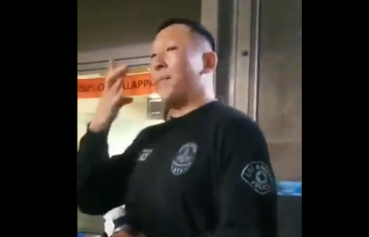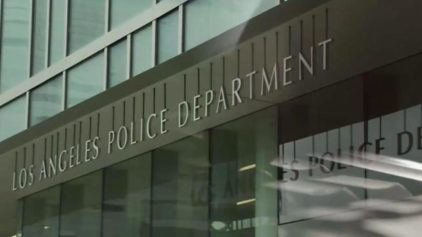If the Christopher Dorner saga is indeed over, as authorities in California have removed charred remains from the burned-down cabin where it was believed he was holed up, then the story of the ex-L.A. cop who allegedly hunted and killed other cops and their family members will go down in history as one of the most memorable and riveting news stories in recent memory, on par with O.J. Simpson’s police chase in the white Bronco or Rodney King’s beating by police.
It appears that Dorner literally went out in a blaze of drama and more death, taking the life of a sheriff’s deputy and wounding another before barricading himself in a cabin in the San Bernardino mountains near Big Bear, northeast of Los Angeles. Dorner’s entrapment in the cabin was carried live on television for hours, though the television stations obeyed the request of law enforcement authorities and refrained from showing the actual cabin where Dorner was trapped, in case he was watching on television and could see from the helicopter images where officers were stationed around him.
There were reports that he had a hostage or two in the cabin, and that was preventing law enforcement from being more aggressive. But that turned out to be false — though there were other reports that Dorner had taken hostages over the weekend and was staying in a cabin with them that was just across the road from the law enforcement command station.
Los Angeles Police spokesman Commander Andrew Smith made one final appeal to Dorner: “If he’s watching this, the message for himself is, ‘Enough is enough. It’s time to turn yourself in; it’s time to stop the bloodshed.’ ”
Though most people were horrified by the violence that Dorner visited upon the police departments in Southern California, his story managed to capture the imagination of many because it was so surreal and larger than life. In a town that packages fictional, violent heroes and sells them to the rest of the world, the Dorner tale felt like something out of a Hollywood studio — an aggrieved former cop with an exceptional set of skills seeks revenge on those who wrongfully terminated him, wreaks havoc and kills four in the process of tearing a trail of violence everywhere he went.
Many people could identify with the claims and passions Dorner expressed in his online manifesto, in which he outlined in painstaking detail the unfairness of his termination from the department and listed the people responsible — in addition to recounting tales of racism and corruption he encountered in his few short years on the LAPD.
While many would say Dorner clearly was unhinged, he was not irrational in his delivery of violence. He encountered many people who didn’t work for law enforcement and he didn’t hurt them. Rick Heltebrake was carjacked at gunpoint by Dorner just before the ex-cop opened fire on the sheriff’s deputies. This is how he described the encounter:
“I saw some movements in the trees, and it was Christopher Dorner. He came out onto the road, out of the snow, and he pointed his big rifle at me and my truck,” said Heltebrake. “I stopped, put my truck in park, put my hands up. He said, ‘I don’t want to hurt you. Just get out and start walking up the road and take your dog with you.’ He was calm. I was calm. I would say I was in fear for my life, but there was no panic. He told me what to do and I did it.”
But Dorner started the whole saga by killing two innocent people, Monica Quan, the daughter of the department lawyer, Randy Quan, who represented him at his hearing, and her fiance, Keith Lawrence. He killed them on Sunday night after they left a Super Bowl party. Then he apparently used a prepaid cellphone to call Randy Quan and taunt him that he should have taken better care of his daughter. Once the details of those murders went public and were linked to Dorner’s manifesto, a wave of fear gripped the law enforcement community and their families in Southern California. Up to 50 people with connections to Dorner were being protected by hundreds of officers, while the entire LAPD went on a state of lockdown, with reports that officers were told to even stop riding motorcycles because that would make them easy targets.
Days later, Dorner allegedly killed a Riverside police officer and wounded his partner when he ambushed them at a traffic light, exponentially ratcheting up the fear factor.
After Dorner tried to hijack a boat, telling the man he encountered that he was taking it to Mexico, law enforcement believed he may have crossed the border. They even found his wallet and ID at one of the border crossings and raided a hotel in Tijuana. But Mexico was apparently a ruse because Dorner had headed in the other direction, into the frigid mountains of San Bernardino, where Los Angelenos traditionally flock to get their skiing fix in the Big Bear ski resort town. Dorner’s pickup truck was discovered in the mountains with a broken axle, leading authorities to center their search on the San Bernardino mountains.
In fact, the pickup truck itself became a target — police opened fire on a mother and daughter newspaper delivery team who were driving a pickup truck, then police in Torrance shot at a thin white man in a pickup truck. The fact that none of these people even remotely resembled the hulking, 270-lb. Dorner just added to the perception of ineffectual police forces.
After the daylong standoff in the mountains yesterday, police say they heard a single gunshot just before the cabin started burning down — clearly the impression they want to leave is that Dorner killed himself rather than emerge from the burning cabin. They still have yet to positively state that the body in the cabin was indeed Dorner. They are likely in the process of using Dorner’s dental records and DNA to ensure that the body is his before making a public statement.


